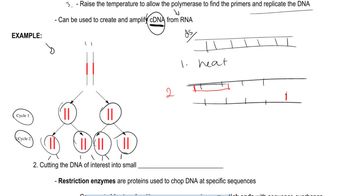Table of contents
- 1. Introduction to Genetics51m
- 2. Mendel's Laws of Inheritance3h 37m
- 3. Extensions to Mendelian Inheritance2h 41m
- 4. Genetic Mapping and Linkage2h 28m
- 5. Genetics of Bacteria and Viruses1h 21m
- 6. Chromosomal Variation1h 48m
- 7. DNA and Chromosome Structure56m
- 8. DNA Replication1h 10m
- 9. Mitosis and Meiosis1h 34m
- 10. Transcription1h 0m
- 11. Translation58m
- 12. Gene Regulation in Prokaryotes1h 19m
- 13. Gene Regulation in Eukaryotes44m
- 14. Genetic Control of Development44m
- 15. Genomes and Genomics1h 50m
- 16. Transposable Elements47m
- 17. Mutation, Repair, and Recombination1h 6m
- 18. Molecular Genetic Tools19m
- 19. Cancer Genetics29m
- 20. Quantitative Genetics1h 26m
- 21. Population Genetics50m
- 22. Evolutionary Genetics29m
18. Molecular Genetic Tools
Genetic Cloning
Problem 7b
Textbook Question
Restriction sites are palindromic; that is, they read the same in the 5' to 3' direction on each strand of DNA. What is the advantage of having restriction sites organized this way?
 Verified step by step guidance
Verified step by step guidance1
<Restriction sites are specific sequences of DNA where restriction enzymes cut. These sites are often palindromic, meaning they read the same forwards and backwards on complementary strands.>
<The palindromic nature of restriction sites ensures that the enzyme can recognize and bind to the same sequence on both strands of the DNA, which is crucial for the enzyme to make a precise cut.>
<When a restriction enzyme binds to a palindromic sequence, it can cut both strands of the DNA at the same location, creating either blunt or sticky ends.>
<Sticky ends, which are overhanging sequences of single-stranded DNA, can easily pair with complementary sequences, facilitating the ligation of DNA fragments.>
<The palindromic structure increases the likelihood of the enzyme binding correctly and efficiently, ensuring that the DNA is cut at the intended site, which is essential for processes like cloning and DNA analysis.>
Recommended similar problem, with video answer:
 Verified Solution
Verified SolutionThis video solution was recommended by our tutors as helpful for the problem above
Video duration:
1mPlay a video:
Was this helpful?
Key Concepts
Here are the essential concepts you must grasp in order to answer the question correctly.
Restriction Enzymes
Restriction enzymes are proteins that cut DNA at specific sequences known as restriction sites. These enzymes are crucial for molecular biology techniques, such as cloning and DNA manipulation, as they allow scientists to precisely cut and paste DNA fragments. The specificity of these enzymes to palindromic sequences ensures that they can recognize and bind to the same sequence on both strands of the DNA.
Recommended video:
Guided course

Mapping with Markers
Palindromic Sequences
Palindromic sequences in DNA are sequences that read the same in both directions on complementary strands. This characteristic is essential for the function of restriction enzymes, as it allows them to bind and cut both strands of the DNA at the same site. The symmetry of palindromic sequences facilitates the recognition and action of these enzymes, making them effective tools in genetic engineering.
Recommended video:
Guided course

Sequencing Difficulties
Genetic Engineering Applications
The organization of restriction sites as palindromic sequences provides significant advantages in genetic engineering. It allows for the precise insertion or deletion of DNA segments, enabling the creation of recombinant DNA. This capability is fundamental in various applications, including gene cloning, the production of genetically modified organisms, and the development of gene therapies, all of which rely on the accurate manipulation of DNA.
Recommended video:
Guided course

Descriptive Genetics

 7:43m
7:43mWatch next
Master Genetic Cloning with a bite sized video explanation from Kylia Goodner
Start learningRelated Videos
Related Practice


